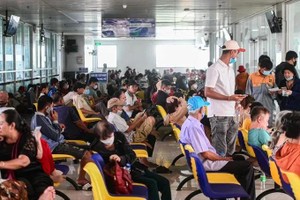
Effective January 1, 2025, the Ministry's Circular No. 37/2024/TT-BYT, which establishes the principles, criteria, and procedures for the development, updating, and maintenance of the health insurance drug list, came into force. This policy reform ensures uniform drug coverage across all medical facilities.
Consequently, all medical facilities will be empowered to utilize the same list of drugs covered by health insurance thereby eliminating the previous classification of hospitals.
A 72-year-old woman in Da Ton Commune of Hanoi’s Gia Lam District suffers from high blood pressure and must take medication daily. Although she is monitored by medical facilities, the local health station does not have enough of the prescribed drugs. As a result, she must travel to the general hospital in the district each month to obtain her necessary medication.
She hopes that the local commune health station will stock a sufficient supply of essential medicines to serve those with chronic conditions and the elderly.
Experts emphasize that the primary health care system is crucial for disease prevention, medical consultations, and providing basic health services to the community. However, the current availability of health insurance-covered medications at health stations is limited to only about 25 percent of the required list. This shortfall forces many patients to seek care at larger facilities rather than utilizing the health stations near their homes.
Moreover, patients often receive prescriptions for 5-6 types of medication, but the health stations typically stock only 3-4 of these under health insurance, leaving patients uncertain about the reliability of the primary health care system for their treatment needs.
According to Vu Nu Anh, Deputy Director of the Department of Health Insurance under the Ministry of Health, the Circular No. 37/2024/TT-BYT, effective from January 1, 2025, will facilitate patients' participation in health insurance and medical examination and treatment facilities.
Specifically, the regulation on dividing the drug list covered by health insurance agency according to hospital classification will be removed, helping medical facilities to use all drugs in the health insurance list, in accordance with the scope of professional activities, diagnosis and treatment instructions regardless of hospital classification.
This will also encourage healthcare facilities to develop expertise and techniques; attract human resources and encourage the development of capacity of medical staff, especially creating conditions for the development of commune and ward health care by ensuring fairness in access and payment of health insurance for drugs.
In addition, it will contribute to limiting the situation of patients choosing to go to high-tech specialized facilities for medical examination and treatment, reducing the overload at these facilities.
The Circular No. 37/2024/TT-BYT also adds new regulations on drug payment instructions. Specifically, the health insurance fund will pay in accordance with the scope of professional activities and capacity to perform technical services regardless of hospital classification. This contributes to increasing access to drugs for patients and medical facilities.
In particular, the Health Insurance Fund also pays in cases where drugs are used without indications or contraindications for patients as stated in the prescribed documents for emergency treatment of patients without alternative drugs, after consultation.
Director Tran Thi Trang of the Health Insurance Department stated that to enhance convenience for patients and healthcare facilities, the Ministry of Health is currently in the process of reviewing, amending, and supplementing the list of health insurance medications. This initiative emphasizes the expansion of the drug list for lower-tier facilities, particularly at the provincial, district, and commune levels, in alignment with the growth of professional capabilities.
Additionally, there is a focus on broadening the availability of medications for certain chronic conditions at primary healthcare facilities to better address treatment needs, facilitate medical examinations, and uphold the rights of health insurance beneficiaries.
The Ministry of Health will also regularly update new drugs that, through evaluation and review, have been shown to be effective in treatment and cost, so that they can contribute to the diagnosis and treatment of diseases at all levels.
On the other hand, drugs with warnings related to treatment, low treatment effectiveness, and drugs with no longer suitable cost-effectiveness will be removed from the list. At the same time, there will be related adjustments in principles and criteria for drug adjustment, ensuring objectivity, science, promoting treatment effectiveness while still ensuring the requirements for balancing the health insurance fund.
Deputy Minister of Health Tran Van Thuan stated that approximately 94 percent of the population is currently covered by health insurance. The reimbursement for medication expenses for health insurance beneficiaries is being conducted in accordance with the list of health insurance medications and the guidelines outlined in the Ministry of Health’s Circular No. 20/2022/TT-BYT. Nevertheless, this reimbursement process has exposed several shortcomings, leading to challenges for both patients and healthcare facilities.
























